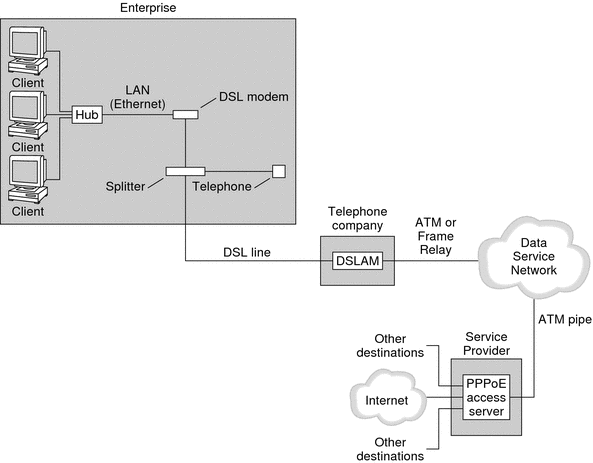Parts of a PPPoE Configuration
Three participants are involved in a PPPoE configuration: a consumer, a telephone company, and a service provider, as the following figure shows.
Figure 15–4 Participants in a PPPoE Tunnel

PPPoE Consumers
As system administrator, you might assist consumers with their PPPoE configurations. One common type of PPPoE consumer is an individual who needs to run PPPoE over a DSL line. Another PPPoE consumer is a company that purchases a DSL line through which employees can run PPPoE tunnels, as illustrated in the previous figure.
The main reason for a corporate consumer to use PPPoE is to offer PPP communications through a high-speed DSL device to a number of hosts. Often, a single PPPoE client has an individual DSL modem. Or, a group of clients on a hub might share a DSL modem that is also connected to the hub by an Ethernet line.
Note –
DSL devices are technically bridges, not modems. However, because common practice is to refer to these devices as modems, this guide uses the term “DSL modem.”
PPPoE runs PPP over a tunnel on the Ethernet line that is connected to the DSL modem. That line is connected to a splitter, which, in turn connects to a telephone line.
PPPoE at a Telephone Company
The telephone company is the middle layer of the PPPoE scenario. The telephone company splits the signal that is received over the phone line by using a device that is called a Digital Subscriber Line Access Multiplexer (DSLAM). The DSLAM breaks out the signals onto separate wires, analog wires for telephone service, and digital wires for PPPoE. From the DSLAM, the digital wires extend the tunnel over an ATM data network to the ISP.
PPPoE at a Service Provider
The ISP receives the PPPoE transmission from the ATM data network over a bridge. At the ISP, an access server that runs PPPoE functions as the peer for the PPP link. The access server is very similar in function to the dial-in server that was introduced in Figure 15–2, but the access server does not use modems. The access server converts the individual PPPoE sessions into regular IP traffic, for example Internet access.
If you are a system administrator for an ISP, you might be responsible for configuring and maintaining an access server.
- © 2010, Oracle Corporation and/or its affiliates
